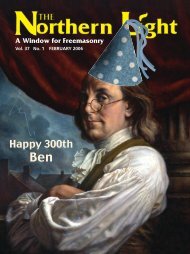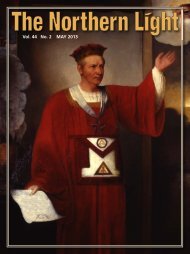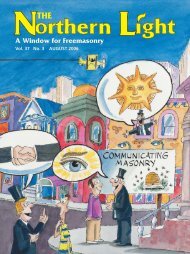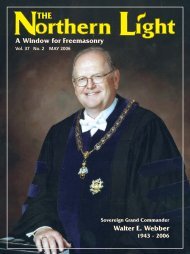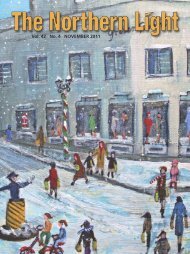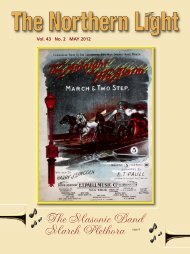The Degree Rituals The Supreme Council, 33 ... - Scottish Rite, NMJ
The Degree Rituals The Supreme Council, 33 ... - Scottish Rite, NMJ
The Degree Rituals The Supreme Council, 33 ... - Scottish Rite, NMJ
Create successful ePaper yourself
Turn your PDF publications into a flip-book with our unique Google optimized e-Paper software.
<strong>The</strong> <strong>Degree</strong> <strong>Rituals</strong><br />
Church and State — <strong>The</strong> Twenty-seventh <strong>Degree</strong><br />
As the 27° was not among the degrees of the <strong>Rite</strong> of Perfection, no reference<br />
to it appeared in the Francken Manuscript. It was mentioned only by<br />
name, “Commander of the Temple,” in an 1804 manuscript of unknown authorship<br />
which provided no hint of the ritual. Moreover, it is unlikely that<br />
any of the Consistorial degrees other than the 30°-32° were conferred in this<br />
jurisdiction prior to 1845.<br />
<strong>The</strong> first ritual of the 27° in authorized use after the Union of 1867 included<br />
an elaborate ceremonial opening and reception of a Prince of Mercy,<br />
26°, into an order of knighthood dedicated to the five qualities of humility,<br />
temperance, chastity, generosity, and honor. <strong>The</strong> chivalric order portrayed in<br />
the ritual was represented to be the historic Order of the Teutonic Knights. Although<br />
some sources have claimed that the 27° ritual originally was based on<br />
the Order of the Knights Templar, there is no evidence to support this contention.<br />
<strong>The</strong> dramatic section did not appear until 1896 when the convocation<br />
scene with a 13th century historical setting was added to the ritual. This addition<br />
greatly extended the length of the ritual and expanded the cast to more<br />
than 50 players with accompanying costume requirements. Another innovation<br />
was that the traditional five qualities were eclipsed in importance by the<br />
three vows of chastity, obedience, and charity.<br />
After nearly half a century, the ritual of 1944 introduced major revisions,<br />
almost all of which affected the original ceremonial opening rather than the<br />
dramatic section. <strong>The</strong> numerous vows assumed by the novice were greatly<br />
condensed and references to his Masonic associations and duties were deleted<br />
as anachronisms in the 13th century setting of the ritual. <strong>The</strong> obligation was<br />
replaced by a shorter cover obligation. <strong>The</strong> historical lecture was removed<br />
and portions incorporated in a new prologue. <strong>The</strong> poetic dirge also was eliminated<br />
and the previous emphasis on the imminence of death was reduced to<br />
the symbolic display of the pendant sword. <strong>The</strong> five qualities, which originally<br />
had been the principal lessons of the degree, disappeared from the ritual.<br />
Belief in a free church within a free state, neither seeking to dominate the<br />
other, as dramatized in the convocation scene, emerged as the primary lesson<br />
of the degree.<br />
71




